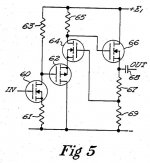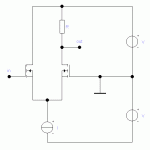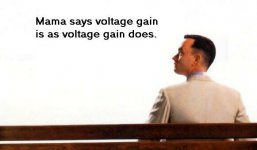Rush cascode - original paper?
Hugh,
Would you mind providing the reference for the
rush cascode publication(s) and the Bailey circuit too?
thanks in advance
Yv
Hugh,
Would you mind providing the reference for the
rush cascode publication(s) and the Bailey circuit too?
thanks in advance
Yv
Hi Yves,
I must apologize; I read about the Rush in a magazine written on ICs by Bryan Maher, published here in Australia and probably about 15 years out of print (I've even lost my copy!). The Rush drew perhaps three sentences of reference, but it was tantalising stuff and caught my attention.
Bailey's stuff goes back to the seventies in Wireless World, and in fact his diff pair version of the Lin topology from 1956 probably predates that.
Not much help, I am sorry, most of this stuff is deep in my history and thrown out long ago.
BTW, the NAD 3020 is definitely a Rush Cascode. When you have a phono preamp with a CLG of 1000 you need an OLG of at least 10000 just to achieve 20dB of feedback, and the single common emitter bipolar amplifier can't achieve this. I am grateful to Dave Dlugos for that timely circuit; I knew NAD was good back then, but hadn't realised that they were so innovative. That's 1 suave circuit, very clever indeed......
Cheers,
Hugh
www.printedelectronics.com
I must apologize; I read about the Rush in a magazine written on ICs by Bryan Maher, published here in Australia and probably about 15 years out of print (I've even lost my copy!). The Rush drew perhaps three sentences of reference, but it was tantalising stuff and caught my attention.
Bailey's stuff goes back to the seventies in Wireless World, and in fact his diff pair version of the Lin topology from 1956 probably predates that.
Not much help, I am sorry, most of this stuff is deep in my history and thrown out long ago.
BTW, the NAD 3020 is definitely a Rush Cascode. When you have a phono preamp with a CLG of 1000 you need an OLG of at least 10000 just to achieve 20dB of feedback, and the single common emitter bipolar amplifier can't achieve this. I am grateful to Dave Dlugos for that timely circuit; I knew NAD was good back then, but hadn't realised that they were so innovative. That's 1 suave circuit, very clever indeed......
Cheers,
Hugh
www.printedelectronics.com
Cascode craziness
I have looked at the NAD phono preamp circuit again and it still CONTAINS NO CASCODES. Q402 and Q402 are a differential pair. Q406 and Q408 are another differential pair. Q410 is a current source. I still see no cascode connected transistors.......
H.H.
I have looked at the NAD phono preamp circuit again and it still CONTAINS NO CASCODES. Q402 and Q402 are a differential pair. Q406 and Q408 are another differential pair. Q410 is a current source. I still see no cascode connected transistors.......
H.H.
With a little imagination
Just what we need for design analysis. Q406 and Q408 are differential pair and provide votage gain. The configuration is to implement a non inverting gain stage. It still is not a cascode stage though, by any stretch of the imagination. I have always seen a cascode described as the connection of two transistors such that the cascode element limits the voltage swing across the amplifying transistor to increase bandwidth, reduce distortion, and increase output impedance of the gain stage.
Just what we need for design analysis. Q406 and Q408 are differential pair and provide votage gain. The configuration is to implement a non inverting gain stage. It still is not a cascode stage though, by any stretch of the imagination. I have always seen a cascode described as the connection of two transistors such that the cascode element limits the voltage swing across the amplifying transistor to increase bandwidth, reduce distortion, and increase output impedance of the gain stage.
Okay, i can follow it. By a deeper thought ... I do not know why i came up with the imagination thing.
Cascode stage is as you descripe two transistor in series. With the cascode runing in common base configuration.
Sonny
Cascode stage is as you descripe two transistor in series. With the cascode runing in common base configuration.
Sonny
It is not differential either!
In a differential pair, increasing the current in one decreases the current in the other.
In the "Rush" circuit, increasing the current in the follower also increases the current in the CB stage.
Two emitters tied together is not a cascode. I don't care what the ponce that designed it thinks.
Jocko
In a differential pair, increasing the current in one decreases the current in the other.
In the "Rush" circuit, increasing the current in the follower also increases the current in the CB stage.
Two emitters tied together is not a cascode. I don't care what the ponce that designed it thinks.
Jocko
Differential pair
At the risk of reading your mind again, I assume you mean Q402 and Q404. Lets see..... ( AC analysis) Increase the difference between the base votages and current increases, decrease difference and current decreases. Little change for common mode voltages. Sounds like a diff amp to me.......
H.H.
At the risk of reading your mind again, I assume you mean Q402 and Q404. Lets see..... ( AC analysis) Increase the difference between the base votages and current increases, decrease difference and current decreases. Little change for common mode voltages. Sounds like a diff amp to me.......
H.H.
It is certainly a diffential in that NAD circuit, it is the half of the well known diamond differential topology.
Back to cascodes please.
I wish to ask the board about the following "cascode".
Take a CE-stage and load the collector with a mere 5 ohms. Then connect a CB-stage to the collector of this circuit. The CE-stage voltage swing is very low (because of the low resistor) just as in a normal cascode. The output impedance is high due to the CB-stage.
Do we agree that this is a cascode ?
Back to cascodes please.
I wish to ask the board about the following "cascode".
Take a CE-stage and load the collector with a mere 5 ohms. Then connect a CB-stage to the collector of this circuit. The CE-stage voltage swing is very low (because of the low resistor) just as in a normal cascode. The output impedance is high due to the CB-stage.
Do we agree that this is a cascode ?
Is this a cascode?
<i><font face="serif">United States Patent 4,647,872
William Zane Johnson March 3, 1987
Cascode amplifier
Abstract
A stabilized Cascode Amplifier Circuit wherein the grid or gate control of the second stage of the cascaded input is provided by feedback of a portion of the output signal voltage. The circuit can be further enhanced by the inclusion of a unity gain follower between the first and third stage of the cascode amplifier circuit</font></i>
<i><font face="serif">United States Patent 4,647,872
William Zane Johnson March 3, 1987
Cascode amplifier
Abstract
A stabilized Cascode Amplifier Circuit wherein the grid or gate control of the second stage of the cascaded input is provided by feedback of a portion of the output signal voltage. The circuit can be further enhanced by the inclusion of a unity gain follower between the first and third stage of the cascode amplifier circuit</font></i>
Attachments
United States Patent 4,647,872
No...... transistors 62 and 64 form a differential pair. Transistor 60 is a common source inverting stage with source degeneration and transistor 66 is a source follower. I don't see any cascode.
This is great, we are arguing about the sound of a cascode and no one can even agree what one looks like! I wonder how many listening observations are even that of a cascode circuit?
http://www.passlabs.com/pdf/cascode.pdf
http://iesg.eecs.berkeley.edu/ee105/Exp10.fm5.html
http://www.iversonsoftware.com/reference/electronics/c.html
No...... transistors 62 and 64 form a differential pair. Transistor 60 is a common source inverting stage with source degeneration and transistor 66 is a source follower. I don't see any cascode.
This is great, we are arguing about the sound of a cascode and no one can even agree what one looks like! I wonder how many listening observations are even that of a cascode circuit?
http://www.passlabs.com/pdf/cascode.pdf
http://iesg.eecs.berkeley.edu/ee105/Exp10.fm5.html
http://www.iversonsoftware.com/reference/electronics/c.html
You could plausibly argue that Q62 is a follower and
Q64 is a cascode, but that same description could apply
to a diff pair. The big difference would seem to be the
missing external current source for the diff pair, but I
don't know that this is required for it to fall into that
category.
Q64 is a cascode, but that same description could apply
to a diff pair. The big difference would seem to be the
missing external current source for the diff pair, but I
don't know that this is required for it to fall into that
category.
Animal vegatable or mineral
An inverted cascode has a current source and a regular cascode doesn't so that distinction maybe is not that relevent. I still vote for a complementary diff pair by my previous rational but I won't lose sleep over the matter.
An inverted cascode has a current source and a regular cascode doesn't so that distinction maybe is not that relevent. I still vote for a complementary diff pair by my previous rational but I won't lose sleep over the matter.
Re: Animal vegatable or mineral
Cast another vote for complementary diff pair. I've also seen it described as such in a few older European electronic texts.
If we can't agree on what to call it, can we agree on how it works and what its merits and deficiencies are? Then, give it an arbitrary name. I bet Jocko's got some goodies...
I love this stuff.
Heh, heh, heh🙂
mlloyd1
Cast another vote for complementary diff pair. I've also seen it described as such in a few older European electronic texts.
HarryHaller said:...I still vote for a complementary diff pair by my previous rational ...
If we can't agree on what to call it, can we agree on how it works and what its merits and deficiencies are? Then, give it an arbitrary name. I bet Jocko's got some goodies...
I love this stuff.
Heh, heh, heh🙂
mlloyd1
cascode is as cascode does
The crux of the matter IMO isn't how the parts are connected but about what is achieved in the end. The object of a cascode is to use one active device to shield another from voltage fluctuations and thereby enhance overall performance of the stage.
There's more than one way to do this, topologically speaking. For example, Horowitz and Hill's "The Art of Electronics" shows how a simple long-tailed pair can be connected as a cascode -- although sticklers might insist that this is more of a folded cascode -- but the effect is the same in the end.
I agree with HH et al that if the circuit doesn't achieve this effect, then it's not a cascode, even if it resembles one superficially.
The crux of the matter IMO isn't how the parts are connected but about what is achieved in the end. The object of a cascode is to use one active device to shield another from voltage fluctuations and thereby enhance overall performance of the stage.
There's more than one way to do this, topologically speaking. For example, Horowitz and Hill's "The Art of Electronics" shows how a simple long-tailed pair can be connected as a cascode -- although sticklers might insist that this is more of a folded cascode -- but the effect is the same in the end.
I agree with HH et al that if the circuit doesn't achieve this effect, then it's not a cascode, even if it resembles one superficially.
Attachments
Joe Berry
All right Joe! Since you have cited Horowitz and Hill's "The Art of Electronics" which is one of the best electronics text ever written, far be it from me to argue with them. If a beer can taste great and be less filling, I guess a diff pair can be a cascode. I will let it rest!
All right Joe! Since you have cited Horowitz and Hill's "The Art of Electronics" which is one of the best electronics text ever written, far be it from me to argue with them. If a beer can taste great and be less filling, I guess a diff pair can be a cascode. I will let it rest!
OKAY ... It is not to sound stupid but what means IMO and IMHO??
For the CASCODE versus DIFF pair thing ... I know that it is basicly a DIFF PAIR .. No doubt about it! .. Harry is right about it.
The reason i got up with the imagination thing is that Q408 looks into a lowimpedance source (D402 and D404) which i think turns the configuration of Q408 into a common base with its high outputimpedance ~ hfe * (1/hoe) ... and its highfrequency performance.
The idlecurrent is the ~1/2 of R418.
The signal source which enters through Q408's emitter is Q406.
But then we could all argue into the next century... But basicly it is a DIFF pair.
Q402 and Q404 is nothing but a DIFF pair.
It was not to continue this debat, only to explain my words.
Sonny
For the CASCODE versus DIFF pair thing ... I know that it is basicly a DIFF PAIR .. No doubt about it! .. Harry is right about it.
The reason i got up with the imagination thing is that Q408 looks into a lowimpedance source (D402 and D404) which i think turns the configuration of Q408 into a common base with its high outputimpedance ~ hfe * (1/hoe) ... and its highfrequency performance.
The idlecurrent is the ~1/2 of R418.
The signal source which enters through Q408's emitter is Q406.
But then we could all argue into the next century... But basicly it is a DIFF pair.
Q402 and Q404 is nothing but a DIFF pair.
It was not to continue this debat, only to explain my words.
Sonny
- Status
- Not open for further replies.
- Home
- Amplifiers
- Solid State
- The sound of cascodes


